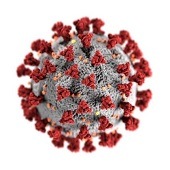 Venous thromboembolism (VTE) in COVID-19 patients was a key topic on the agenda of The VEINS (Venous Endovascular INterventional Strategies) session at VIVA 2020 (Vascular InterVentional Advances; 14–15 November, virtual). Based on emerging data and guidelines, Yogen Kanthi (National Heart, Lung and Blood Institute, Bethesda, USA) gave an overview of VTE management in this population, highlighting the importance of using evidence-based prophylaxis and enrolling patients in clinical trials to aid better understanding of outcomes.
Venous thromboembolism (VTE) in COVID-19 patients was a key topic on the agenda of The VEINS (Venous Endovascular INterventional Strategies) session at VIVA 2020 (Vascular InterVentional Advances; 14–15 November, virtual). Based on emerging data and guidelines, Yogen Kanthi (National Heart, Lung and Blood Institute, Bethesda, USA) gave an overview of VTE management in this population, highlighting the importance of using evidence-based prophylaxis and enrolling patients in clinical trials to aid better understanding of outcomes.
Kanthi began by addressing the incidence of thrombosis in patients with COVID-19, reporting VTE rates as high as 69% in patients who are in the intensive care unit (ICU).
This led the presenter to consider whether higher-dose VTE prophylaxis is a feasible treatment option in COVID-19 patients, noting that there are lessons to be learned from the 2010 H1N1 (swine flu) epidemic in this instance. Kanthi detailed that his colleague Andrea Obi and team at the University of Michigan (Ann Arbor, USA) conducted a study in which they first observed whether patients who were admitted to the hospital and had acute respiratory distress syndrome (ARDS) without H1N1 had a difference in clot-free survival based on whether they were treated with standard VTE prophylaxis or low-dose anticoagulation, “which is a higher dose than standard VTE prophylaxis,” he noted. The team found that there was no statistically significant difference between the two.
On the other hand, when they observed this in patients with confirmed H1N1 infection, those patients who had the infection and were treated with standard prophylaxis had a lower event-free survival than those patients who were given low-dose anticoagulation or higher-dose VTE prophylaxis. Considering how these results could help to treat COVID-19 patients with VTE, Kanthi posited: “Perhaps anticoagulation could be important in COVID-19, where excessive inflammation is a hallmark of this viral infection.”
Kanthi also considered data regarding anticoagulation in COVID-19. For example, a retrospective observational study of 2,700 hospitalised patients in New York found that treatment with standard anticoagulation was no different than treatment with full therapeutic anticoagulation, he reported. Conversely, when the research team focused on those patients at the highest risk—those in the ICU on mechanical ventilation—the investigators found that treatment with full anticoagulation had a significantly higher survival probability compared with those patients who received standard VTE prophylaxis.
While the aforementioned studies focus on retrospective observational data, Kanthi highlighted that there are now over 45 trials of anticoagulation and antithrombotic agents in patients hospitalised with COVID-19. He noted that he and colleagues at the University of Michigan have been leading the DICER study, designed to assess whether treating patients with the drug dipyridamole—which suppresses immune hyperactivation and platelets—can also reduce incidence of thrombosis and D-dimer levels in patients who are hospitalised and need oxygen. The NIH-sponsored ACTIV-4 trial is testing whether therapeutic anticoagulation can benefit patients hospitalised with COVID-19.
Considering treatment options, Kanthi relayed that several societies have released anticoagulation guidelines. He told viewers that the Anticoagulation Forum suggest anticoagulation dosing that “aligns closely with those recommended by the American Society of Haematology,” in recommending that, for patients who are not hospitalised with COVID-19, standard-dose VTE prophylaxis could be considered if these patients are at high risk of VTE.
For patients who are hospitalised with COVID-19 to the non-ICU ward, the Anticoagulation Forum recommends that “all patients should receive standard-dose VTE prophylaxis,” Kanthi added. For patients who are sicker, with either ARDS or have been admitted to the ICU and are on mechanical ventilation, “it would be reasonable to consider using intermediate- or escalated-dose VTE prophylaxis, based on studies of the H1N1 epidemic,” the presenter communicated. Finally, he reported that, for those patients who have confirmed VTE or suspected VTE, the guidelines suggest therapeutic full-dose anticoagulation. “In the absence of clinical data, the American College of Chest Physician guidelines suggest a standard dose of VTE prophylaxis for all patients,” Kanthi detailed.
“For those patients who are discharged after a COVID-19 hospitalisation, we know that the incidence of VTE is <1%, which is similar to the pre-COVID-19 era, and so the Anticoagulation Forum guidelines suggest that post-hospitalisation anticoagulation does not need to be routine, but can be considered if using clinical trial inclusion criteria,” he explained. While the American College of Chest Physician guidelines say the same, the International Society of Thrombosis and Haematology (ISTH) suggest that if patients are at high risk for VTE and at low risk of bleeding, post-hospital anticoagulation can be considered.
Concluding, Kanthi stressed the importance of evidence-based prophylaxis, and enrolling patients in clinical trials, such as the ACTIV-IV or DICER trials to get evidence-based treatment approaches.
With regards to post-hospitalisation VTE prophylaxis, he summarised that the clinical trial criteria should be used in the absence of other evidence, and stressed that “patient selection is key” due to the similar incidence of VTE in post-hospitalisation patients as before the COVID-19 pandemic. Again, he urged viewers to enrol patients in clinical trials, such as ACTIV-IV, “to better understand whether these treatment modalities will actually influence clinical outcomes”.












